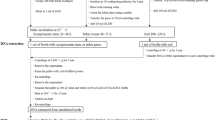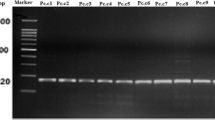Abstract
An improved method for detection, quantification and classification of soft rot bacteria associated with potato seed tubers, plant material, soil and water has been developed. The method is based on the use of a modified version of the crystal violet pectate selective medium (CVP), enrichment cultures under anaerobic conditions using pectate as the sole carbon source for recovery improvement, and the quantitative estimation ofErwinia spp. by employing a new solid medium - most probable number (MPN) method. The use of this method enabled an improvement in the recovery and identification of specificErwinia spp. in mixed populations. This was done by incubating CVP plates — used for the MPN counting — at three different temperatures (15, 28 and 39°C). These combined techniques were used for estimating low level populations at less than one cell per gram or ml tested ofErwinia carotovora subsp.carotovora, E. carotovora subsp.atroseptica, andE. chrysanthemi.
Similar content being viewed by others
References
Allan, E. and Kelman, A. (1977) Immunofluorescent strain procedures for detection and identification ofErwinia carotovora via. atroseptica.Phytopathology 67:1305- 1312.
Ayers, S.H., Rupp, P. and Johnson, W.T. (1919) A Study of the Alkali Forming Bacteria in Milk.Bull. U.S. Dep. Agric. 782.
Brenner, D.J., Steigerwalt, A.G., Miklos, G.V. and Fanning, G.R. (1973) Deoxyribonucleic acid relatedness among Erwiniae and other Enterobacteriaceae: The soft-rot organisms (genusPectobacterium Waldee).Int. J. system. Bact. 23:205–216.
Burr, T.J. and Schroth, M.N. (1977) Occurrence of soft rotErwinia spp. in soil and plant material.Phytopathology 67:1382–1387.
Cother, E.J. and Vruggink, H. (1980) Detection of viable and non-viable cells ofErwinia carotovora var.atroseptica in inoculated tubers of var. Bintje with enzyme-linked immunosorbent assay (ELISA).Pot. Res. 23:133–135.
Cowan, S.T. (1974) Cowan and Steel’s Manual for the Identification of Medical Bacteria. 2nd ed. Cambridge University Press, London.
Cupples, D. and Kelman, A. (1974) Evaluation of selective media for isolation of soft rot bacteria from soil and plant tissue.Phytopathology 64:468–475.
Dean, A.C.R. and Hinshelwood, C. (1966) Growth, Function and Regulation in Bacterial Cells. Oxford at the Clarendon Press, London, UK.
De Boer, S.H., Copeman, R.J. and Vruggink, H. (1979) Serogroups ofErwinia carotovora potato strains determined with diffusible somatic antigens.Phytopathology 69:316–319.
De Boer, S.H. and Kelman, A. (1978) Evaluation of procedures for detection of pectolyticErwinia spp. on potato tubers.Am. Pot. J. 52:117–123.
Kelman, A. and Dickey, R.S. (1980) Soft rot or ‘carotovora’ group,in: Schaad, N.W. [Ed.] Laboratory Guide for Identification of Plant Pathogenic Bacteria, pp. 31–35. The American Phytopathological Society, St. Paul, MN.
Lelliott, R.A. (1974) Genus XII.Erwinia.in: Buchanan, R.E. and Gibbons, N.E. [Eds.] Bergey’s Manual of Determinative Bacteriology. 8th ed. pp. 332–339. Williams and Wilkins, Baltimore, MD.
Lumb, V.M., Pérombelon, M.C.M. and Zutra, D. (1986) Studies of a wilt disease of the potato plant in Israel caused byErwinia chrysanthemi.Pl. Path. 35:196–202.
Meneley, J.C. and Stanghellini, M.E. (1976) Isolation of soft rotErwinia spp. from agricultural soils using an enrichment technique.Phytopathology 66:367–670.
Meynell, G.G. and Meynell, E. (1970) Theory and Practice in Experimental Bacteriology. 2nd ed. Cambridge University Press, Cambridge, UK.
Moran, F. and Starr, M.P. (1969) Metabolic regulation of polygalacturonic acid trans- eliminase inErwinia.Eur. J. Biochem. 11:291–295.
O’Neill, R.O. and Logan, C. (1975) A comparison of various selective isolation media for their efficiency in the diagnosis and enumeration of soft rot coliform bacteria.J. appl.Bact. 39:139–146.
Pérombelon, M.C.M. (1974) The role of the seed tuber in the contaminationof Erwinia carotovora of potato crops in Scotland.Pot. Res. 17:187–199.
Pérombelon, M.C.M., Gullings-Handley, J. and Kelman, A. (1979) Population dynamics ofErwinia carotovora and pectolyticClostridium spp. in relation to decay of potatoes.Phytopathology 69:167–173.
Pérombelon, M.C.M. and Hyman, LJ. (1986) A rapid method for identifying and quantifying soft rot erwinias directly from plant material based on their temperature tolerances and sensitivity to erythromycin.J. appl. Bact. 60:61–66.
Samson, R. (1973) LesErwinia Pectinolytiques II. Recherches sur les antigènes somatiquesd’Erwinia carotovora var.chrysanthemi (Burkholder) Dye 1969.Ann. Phytopath. 5:377–388.
Samson, R. and Nassan, N.A. (1979) Biovars and serovars among 179 strains ofErwinia chrysanthemi. Proc. 4th Int. Conf. Plant Pathology and Bacteriology (Angers, 1978), pp. 547–553.
Schaad, N.W. (1979) Serological identification of plant pathogenic bacteria.A. Rev. Phytopath. 17:123–147.
Starr, M.P. (1981) The genusErwinia.in: Starr, M.P., Stolp, H., Truper, H.G., Balows, A. and Schlegel, H.G. [Eds.] The Prokaryotes. pp. 1260–1271. Springer-Verlag, Berlin.
Stewart, DJ. (1962) A selective-diagnostic medium for the isolation of pectinolytic organisms in the Enterobacteriaceae.Nature (Lond.) 195:1023.
Varns, J.L. and Glynn, M.T. (1979) Detection of disease in stored potatoes by volatile monitoring.Am. Pot. J. 56:185–197.
Yakrus, M. and Schaad, N.W. (1979) Serological relationships among strains ofErwinia chrysanthemi.Phytopathology 69:517–522.
Author information
Authors and Affiliations
Additional information
Contribution from the Agricultural Research Organization. No. 2621-E, 1989 series
Rights and permissions
About this article
Cite this article
Krttzman, G. Detection, quantification and classification of soft rot erwinias associated with potato tubers. Phytoparasitica 17, 205–219 (1989). https://doi.org/10.1007/BF02979538
Received:
Revised:
Issue Date:
DOI: https://doi.org/10.1007/BF02979538




